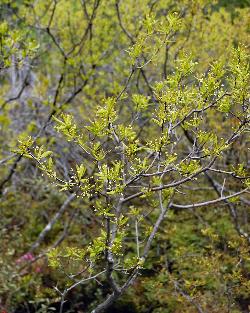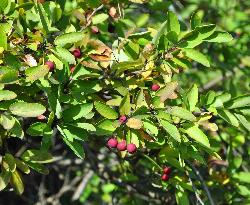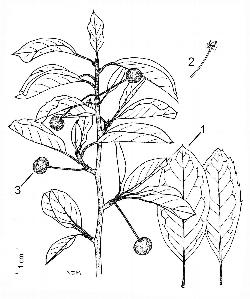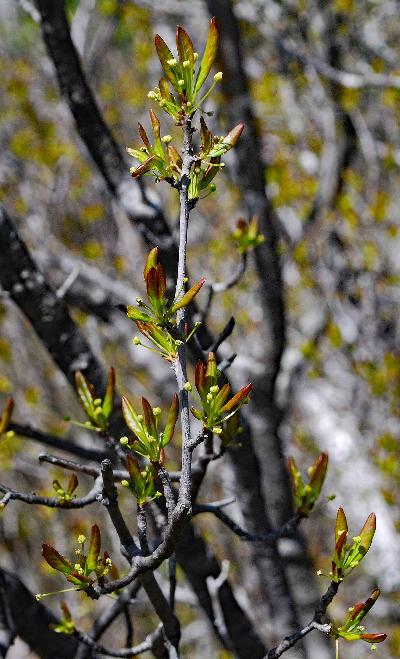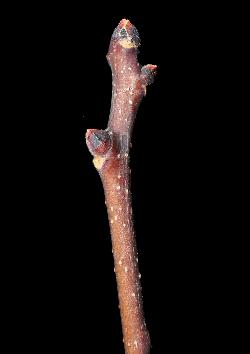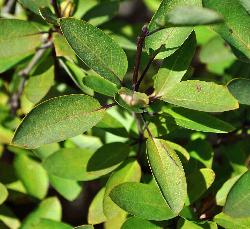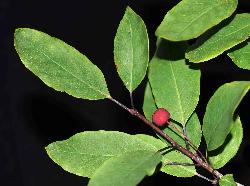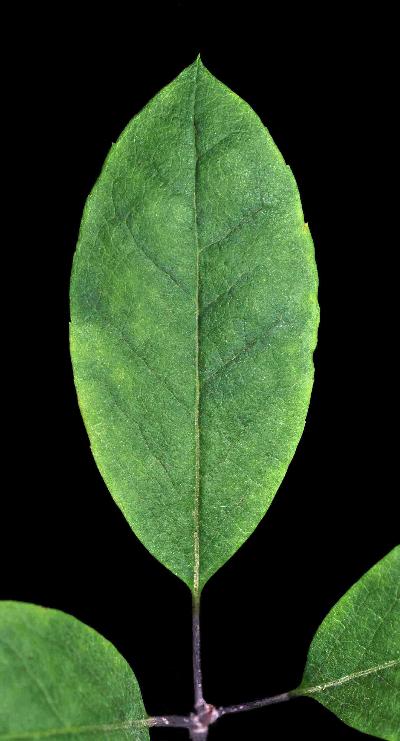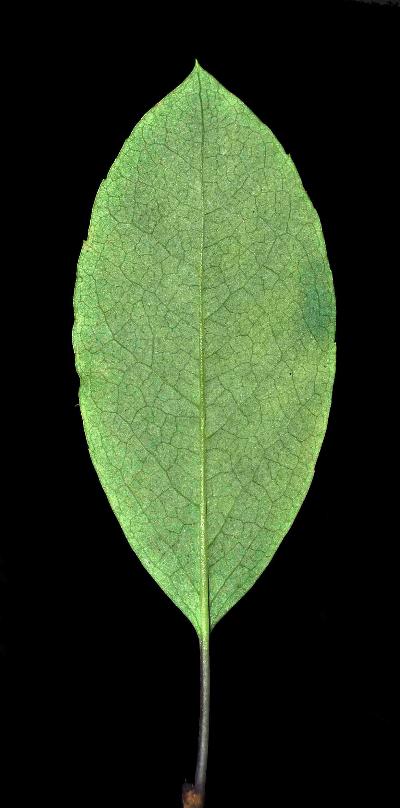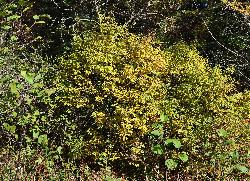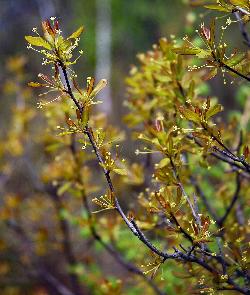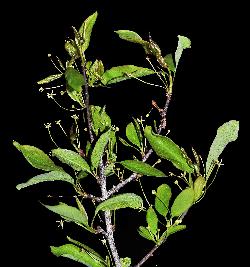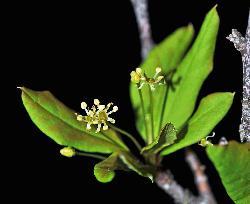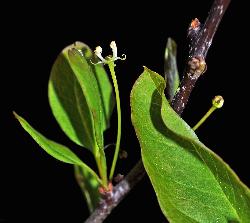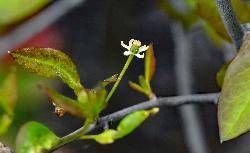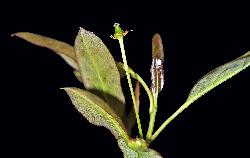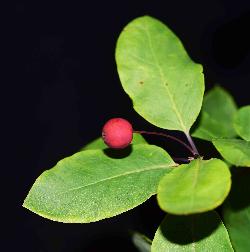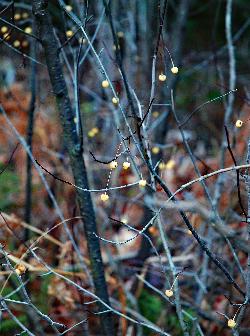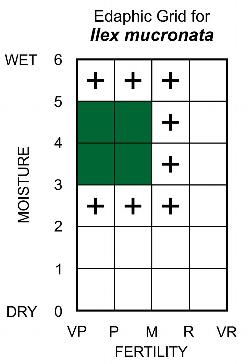Fr: némopanthe mucroné, faux houx
IA: nipiminan (the fruit)
Aquifoliaceae - Holly Family
Note: Numbers provided in square brackets in the text refer to the image presented above; image numbers are displayed to the lower left of each image.
General: An open-branched deciduous shrub of wet habitats, 0.3–3 m tall, with inconspicuous unisexual yellow flowers and red to magenta berry-like drupes [1–3]. Mountain holly was previously known by the scientific name Nemopanthus mucronatus (L.) Trel., but research by Powell et al. (2000) and Cuénoud et al. (2000), clearly showed that the genus Nemopanthus should be included within Ilex. The few characters that distinguish Ilex mucronata from most other Ilex species include its reduced, early deciduous (caducous) calyx and its distinct (separate) petals (Cuénoud et al. 2000). It is also more closely related to Asian species of Ilex than North American species, which often have evergreen leaves.
Key Features: (numbers 1–3 refer to the illustration [4])
1. Leaves alternate, elliptic to oblanceolate, with purple petioles, short bristle-like mucronate tips (apices), and entire to slightly toothed margins.
2. Flowers are small, yellow, unisexual, and borne on long slender stalks in leaf axils; appearing with the emerging leaves.
3. Red to bright magenta globose berry-like drupes, 6–8 mm in diameter, borne on long stalks.
Stems/twigs: The bark is smooth (glabrous), ash-gray, and often distinctly mottled [5]. Twigs are reddish-purple to purplish-brown, glabrous, and marked with scattered lenticels. Terminal buds are conical, lateral buds are also conical but somewhat smaller. The 2-3 brownish to dark purple bud scales are lighter in colour towards the edge and have minutely ciliate margins [6]; leaf scars are broadly-triangular with a single bundle scar.
Leaves: Alternate, simple, and pinnately-veined; petioles are distinctly purple and 0.5–2 cm long [7–8]. Leaf blades are elliptic to oblanceolate, glabrous, and 1.5–8 cm long by 1–2.5 cm wide; young leaves are yellowish-green and tinged with bronze; upper leaf surfaces of mature leaves are bright green to bluish-green [9] and slightly paler beneath [10]. Leaf bases are tapering (cuneate) to rounded, apices are pointed (obtuse to acute) and terminate in a short bristle (mucronate); margins are entire or with a few sharply-pointed teeth towards the apex [11]. Leaves turn yellow in autumn [12].
Flowers: Usually unisexual, with functionally male or female flowers on different shrubs (plants dioecious), but occasional bisexual flowers may occur on the same shrub (plants polygamodioecious). Flowers are small, somewhat hidden by the emerging leaves and therefore easily overlooked until the flower stalks (peduncles) elongate [13–14]. Both male and female flowers are axillary and solitary, or occasionally in few-flowered clusters, with long slender peduncles about 2.5–5 cm long [15]. All flowers have a minute 4–5-toothed calyx and 4–5 narrow pale yellow to yellowish-green linear petals; male flowers are 2–3 mm across; female flowers are 4–5 mm across (Glenn 2013). Male (staminate) flowers occur in fascicles of 1–3, have 4–5 stamens and a reduced, non-functioning (vestigial) pistil [16–17]. Female (pistillate) flowers have a single pistil with a superior ovary topped by a sessile lobed stigma; the pistil is surrounded by 4–5 small vestigial stamens that soon shrivel and drop off [18–19]. Flowers bloom in Spring as the leaves are expanding. Pollination is by a variety of small insects (entomophily), primarily syrphid flies, fever flies, mining bees, sweat bees, honeybees, and bumblebees (Small 1967).
Fruit: The fruit are smooth, globose, berry-like drupes borne on long slender stalks (peduncles) [20–21], about 2.5 cm long, originating from leaf axils. Young fruits are green and ovoid [23], while mature drupes are globose and matte red to bright magenta [24–25], 6–8 mm in diameter, with dark reddish-purple bitter flesh, and contain 4–5 light brown pits (pyrenes), each enclosing a single seed. Plants with pale yellow fruit (forma chrysocarpa (Farw.) Fernald) are occasionally found [26]. Fruits mature in late summer and are dispersed by frugivorous birds (endozoochory), particularly ruffed grouse, robins (Van Dersal 1938), and migrating songbirds (Peronto and Manley 2008), as well as black bears (Glenn 2013).
Ecology and Habitat: Mountain holly can be found on dry sites, but grows most vigorous and abundant on open medium-nutrient moist to wet sites, such as black spruce bog and fen habitats. It is shade-intolerant and, while it occurs in early succession after disturbance, does not spread rapidly. Damman (1965, 1967) includes mountain holly in a group of plants, including northern wild raisin and rhodora, that are considered common throughout the Island, but have a sporadic occurrence on the Northern Peninsula. In eastern Canada, mountain holly is used with other species to differentiate the Boreal region from the Hemiboreal. In addition to the forest sites listed below, mountain holly can occur on moist to wet thickets and ditches, shorelines of ponds and lakes, and borders of bogs and swamps.
Edaphic Grid: See image [27]: the Edaphic Grid for Ilex mucronata.
Forest Types: Mountain holly is absent from Labrador but occurs in the following Newfoundland forest types:
Abietum typicum (Pleurozium-Balsam Fir Subassociation)
Abietum gaultherietosum (Gaultheria-Balsam Fir Subassociation)
Piceetum marianae (Black Spruce-Moss Association)
Betuletum typicum (White Birch on unstable soils Subassociation)
Kalmio-Piceetum typicum (Kalmia-Black Spruce Subassociation)
Kalmio-Piceetum nemopanthetosum (Nemopanthus-Kalmia-Black Spruce Subassociation)
Kalmio-Piceetum taxetosum (Taxus-Kalmia-Black Spruce Subassociation)
Sphagno-Piceetum nemopanthetosum (Nemopanthus-Black Spruce Subassociation)
Osmundo-Piceetum (Osmunda-Black Spruce Association)
Succession: The ecology of mountain holly is poorly understood and its reaction to disturbance is uncertain. It does survive on cutovers (Northland Associates 1990).
Distribution: Mountain holly is a north-temperate to southern-boreal eastern North American species with a range that extends from Newfoundland west to primarily northeastern Ontario (Scoggan 1978, Soper & Heimburger 1982); it is absent from Labrador. Within Newfoundland, mountain holly occurs across the Island, but has not been documented from the southern Avalon Peninsula. In the United States, it occurs from New England west to Minnesota and southwest to eastern West Virginia (USDA, NRCS 2016).
Similar Species: Mountain holly fruits appear similar to those of chuckleypears (Amelanchier spp.) but the latter have a different fruit type (pomes) with a persistent 5-lobed calyx at the top of each dark red to purple fruit. Chuckleypear species also have serrate leaf margins and larger white-petalled flowers arranged primarily in racemes, except for mountain chuckleypear (A. bartramiana (Tausch) M. Roem.), which has 1–3 flowers in the leaf axils.



